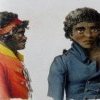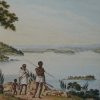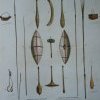1810s
1812
1813
Bennelong dies and is buried in the garden of James Esquire, possibly where a boatshed used to stand in Waterview Street, Ryde, in what is now Bennelong Park. Over time the site of the burial becomes lost, but in 2011 it is claimed that the actual site may be identified soon. http://www.abc.net.au/news/stories/2011/03/20/3168672.htm?section=justin; see also Keith Vincent Smith, 'Bennelong among his people' in Aboriginal History Vol 33
Mahroot goes on many voyages from about 1809. In 1813 he writes to Governor Macquarie, “Sir, my name is Merute an inhabitant and native of this country. I agreed verbally for plenty of money and clothes and can obtain nothing, is this an encouragement to us? (p. 152) - These voyages continue until 1822 after which he settles down in Kameygal country. (Vincent Smith p. 149)
1814
An Aboriginal sailor, when asked why he plans to rejoin his own people, replies, ‘when will you keep me company, or when any white man or woman keep me company? White men will marry white men, but no white woman will have me; then why wish me to keep away from my own people, when no other will look upon me? (Sydney Gazette, 1/1/1814)
1815
Many long time Sydney residents still know some Aboriginal people by name. They are accustomed to their nakedness or motley clothing, their feuds and their politics. They are provided with food, fishhooks and clothes and boat crews continue to exploit them as workers - but listen to the news they carry. Colonists uphold the Sydney tradition of non-interference in Aboriginal business, for within the law English administrators do not harass them. (Karskens, p. 446)
1816
Macquarie bans Koori revenge or marriage disputes altogether, stating that ‘the practice of assembling in large Bodies armed, fighting and attacking ... at or near Sydney and other principal Towns and Settlements will be abolished as a barbarous Custom, repugnant to British Laws.’ (Karskens, p. 445)

















